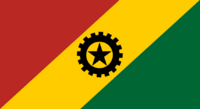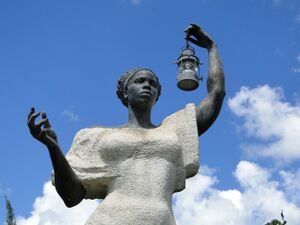National symbols of Batisuria: Difference between revisions
| (3 intermediate revisions by the same user not shown) | |||
| Line 4: | Line 4: | ||
! Name !! Symbol !! Introduced !! Notes | ! Name !! Symbol !! Introduced !! Notes | ||
|- | |- | ||
| State Flag of the Peoples' Democratic Republic || [[File:Marensoald1.png|200px]] || 1958-Present || Introduced on 1 January, 1958, and first raised during the inaugural celebrations of [[Artoir Adewale]], declaring the end of both the first five-year plan and full instatement of the | | State Flag of the Peoples' Democratic Republic || [[File:Marensoald1.png|200px]] || 1958-Present || Introduced on 1 January, 1958, and first raised during the inaugural celebrations of [[Artoir Adewale]], declaring the end of both the first five-year plan and full instatement of the Batisurian Constitution. The flag utilizes the {{wpl|Pan-African Colors|Pan-Majulan Colors}} representing the shared blood of all Majulan peoples and the struggle for freedom (red), mineral wealth (yellow), and ecological heritage (green). The Gear has 19 teeth, representing the 19 Districts of the nation, and the Black Star at its center represents "the light of Batisuria shining on the world". | ||
|- | |- | ||
| | | Batisurian Revolutionary Flag || || 1947-1957 || The adopted flag of the United Patriotic Front during the second phase of the [[Batisurian Long War|Long War]], this standard was flown up through the Provisional and Pre-Constitutional Periods of postwar Batisuria. Though it was dropped following the instatement of the Constitution, the Revolutionary Flag is flown today as part of celebrations commemorating both the end of the revolution and the birthday of [[Artoir Adewale]]. Following the style of the Federated Socialist Republics and its constituent states, the movement and later, nation, chose to emulate such design elements to show solidarity in purpose with the rest of the Socialist Revolutions which preceded it. While all colors have translated to the modern flag, Mawusi Blue was included up until the Treaty of Fortnouveau, which established it as a separate polity. | ||
|- | |- | ||
|} | |} | ||
| Line 23: | Line 23: | ||
===Music=== | ===Music=== | ||
===Art=== | ===Art=== | ||
==" | =="Mère Batisourie"== | ||
{{ | [[File:Mothermarensoald.jpg|300px|thumb|right|''Mère Batisourie Guides The Way to Freedom'', located in [[Valjardin]].]] | ||
Mère Batisourie, or Mother Batisuria is the personification of the country. This symbol finds its origin in anti-colonial and anti-racist publications of the late 19th and early 20th Centuries, which characterized the practices as defiling the purity and natural freedom of Mother Batisuria and her "children natural and adopted", in an attempt to solidify Togacien and indigenous populations in solidarity against minority rule and their historical and ongoing exploitation of both groups. Mère Batisourie is said to represent the nation's natural fertility and beauty, aspirations of peace, and quiet dignity. They are often depicted holding a torch or lantern, representing Batisuria's place as a "guiding light" to the rest of the Majulan continent in its struggle towards freedom. | |||
The most famous monument to this expression of the national character is ''Mère Batisourie Guides The Way to Freedom'', a monumental statue constructed atop Dedication Hill in [[Valjardin]], the nation's capital. Excluding the pedestal, it is the largest statue of a woman in [[Majula]], and the largest of any statue in Marensoald. The statue features on many forms of currency utilized across the nation, and is a popular symbol of the country abroad. | |||
{{Batisuria}} | |||
Latest revision as of 00:50, 20 June 2019
Flags and Seals
National Flags and Seal
| Name | Symbol | Introduced | Notes |
|---|---|---|---|
| State Flag of the Peoples' Democratic Republic |  |
1958-Present | Introduced on 1 January, 1958, and first raised during the inaugural celebrations of Artoir Adewale, declaring the end of both the first five-year plan and full instatement of the Batisurian Constitution. The flag utilizes the Pan-Majulan Colors representing the shared blood of all Majulan peoples and the struggle for freedom (red), mineral wealth (yellow), and ecological heritage (green). The Gear has 19 teeth, representing the 19 Districts of the nation, and the Black Star at its center represents "the light of Batisuria shining on the world". |
| Batisurian Revolutionary Flag | 1947-1957 | The adopted flag of the United Patriotic Front during the second phase of the Long War, this standard was flown up through the Provisional and Pre-Constitutional Periods of postwar Batisuria. Though it was dropped following the instatement of the Constitution, the Revolutionary Flag is flown today as part of celebrations commemorating both the end of the revolution and the birthday of Artoir Adewale. Following the style of the Federated Socialist Republics and its constituent states, the movement and later, nation, chose to emulate such design elements to show solidarity in purpose with the rest of the Socialist Revolutions which preceded it. While all colors have translated to the modern flag, Mawusi Blue was included up until the Treaty of Fortnouveau, which established it as a separate polity. |
Sub-National Flags and Seals
Below are all Flags and Seals utilized by sub-national divisions including Unions and Districts.
Caval Itam
Enanulo
Enewatu
Matav
Sepp
Flora and Fauna
Food and Drink
Media
Literature
Music
Art
"Mère Batisourie"

Mère Batisourie, or Mother Batisuria is the personification of the country. This symbol finds its origin in anti-colonial and anti-racist publications of the late 19th and early 20th Centuries, which characterized the practices as defiling the purity and natural freedom of Mother Batisuria and her "children natural and adopted", in an attempt to solidify Togacien and indigenous populations in solidarity against minority rule and their historical and ongoing exploitation of both groups. Mère Batisourie is said to represent the nation's natural fertility and beauty, aspirations of peace, and quiet dignity. They are often depicted holding a torch or lantern, representing Batisuria's place as a "guiding light" to the rest of the Majulan continent in its struggle towards freedom.
The most famous monument to this expression of the national character is Mère Batisourie Guides The Way to Freedom, a monumental statue constructed atop Dedication Hill in Valjardin, the nation's capital. Excluding the pedestal, it is the largest statue of a woman in Majula, and the largest of any statue in Marensoald. The statue features on many forms of currency utilized across the nation, and is a popular symbol of the country abroad.